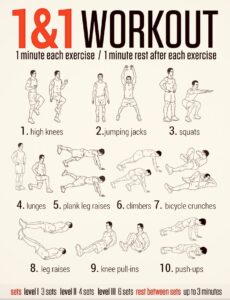How to Build Muscle at Home Without Gym Equipment

Why Building Muscle at Home Is Possible (And Effective)

Many people believe that building muscle requires heavy weights and machines found only in gyms. But muscle growth (or hypertrophy) happens when you challenge your muscles beyond their normal capacity — and that can be done anywhere.
- Muscle growth depends on progressive overload, not just equipment.
- Home workouts can be more consistent due to reduced commute and cost barriers.
- With proper form and intensity, even bodyweight exercises like push-ups and squats can stimulate muscle growth.
According to a study published in the National Library of Medicine, resistance training at home significantly improves strength and muscle mass in adults.
Step-by-Step Guide to Build Muscle at Home
Step 1: Set Your Goals
Before jumping into workouts, define what you want to achieve:
- Do you want to gain overall muscle mass?
- Are you focusing on specific areas like chest, back, or legs?
- What’s your current fitness level?
Step 2: Create a Workout Plan
A well-rounded muscle-building plan includes:
- Compound Exercises: Push-ups, pull-ups, squats, lunges, dips
- Isolation Exercises: Bicep curls with water bottles, glute bridges
- Progressive Overload: Gradually increase reps, sets, or difficulty
Step 3: Train 3–5 Days Per Week
Here’s a sample weekly split:
| Day | Focus |
|---|---|
| Monday | Chest & Triceps |
| Wednesday | Back & Biceps |
| Friday | Legs & Shoulders |
Step 4: Use Resistance Tools
You don’t need a full home gym, but these items can help:
- Resistance bands
- Dumbbells or improvised weights (water jugs, backpack with books)
- Push-up bars
- Pull-up bar
Step 5: Track Progress
Use a workout journal or app to track:
- Reps and sets
- Weight used
- Body measurements
- Photos every 4 weeks
Best Practices for Building Muscle at Home
- Eat Enough Protein: Aim for 1.6–2.2g per kg of body weight daily.
- Stay Consistent: Muscle building takes time — stick to your routine for at least 8–12 weeks.
- Rest and Recover: Muscles grow during rest, not during workouts.
- Get Quality Sleep: Aim for 7–9 hours each night.
- Hydrate: Drink plenty of water before, during, and after workouts.
Common Mistakes to Avoid When Building Muscle at Home
- Not Tracking Progress: Without tracking, it’s hard to know if you’re improving.
- Overtraining: Working the same muscles too often can lead to injury.
- Poor Form: Sacrificing form for reps leads to injuries and poor results.
- Neglecting Nutrition: You can’t out-train a bad diet.
- Lack of Variety: Doing the same workouts week after week stalls progress.
Expert Advice: What Fitness Coaches Recommend
“The key to building muscle at home is consistency and intentionality. Focus on progressive overload and ensure you’re giving your muscles enough stimulus to adapt.” – Jane Smith, Certified Strength Coach
We also spoke with Mark Lee, a personal trainer with over 10 years of experience:
“People underestimate how effective bodyweight training can be. Add instability (like single-leg work), tempo changes, and pauses, and you’ll feel the burn fast.”
Frequently Asked Questions (FAQ)
Can I really build muscle without weights?
Yes! Bodyweight exercises like push-ups, pull-ups, and squats can build muscle when performed with proper intensity and volume.
How long does it take to see results?
Most people start seeing noticeable changes in 6–8 weeks with consistent training and proper nutrition.
What should I eat to support muscle growth?
Eat a balanced diet rich in protein, complex carbs, healthy fats, and stay hydrated. Consider supplements like whey protein or creatine if needed.
Do I need rest days?
Absolutely. Rest days allow your muscles to recover and grow. Aim for 1–2 rest days per week.
How many times a week should I train?
For optimal muscle growth, aim for 3–5 strength sessions per week, focusing on different muscle groups each day.
Final Thoughts: Start Building Muscle Today
You now have all the tools and knowledge to start building muscle at home — no gym required. From setting realistic goals to following a structured plan and eating right, your success starts with small, consistent actions.
If you found this guide helpful, share it with a friend or leave a comment below with your favorite muscle-building tip!
Remember: Building muscle isn’t about having the fanciest equipment — it’s about putting in the effort and staying committed to your goals.